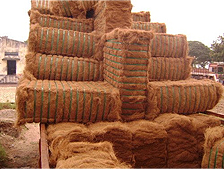


Alleppey Coir
Alleppey is famous through out the world for its production of coir and coir products just like the spices from Kerala,India. Traditional uses for the resilient and durable coir fiber include rope and twine, brooms and brushes, doormats, rugs, mattresses and other upholstery, often in the form of rubberized coir pads.
Coir fibers are produced from the green husk of coconut. The individual fibre cells are narrow and hollow, with thick walls made of cellulose. They are pale when immature but later become hardened and became yellowish in colour.
There are two varieties of coir. Brown coir is harvested from fully ripened coconuts. It is thick, strong and has high abrasion resistance. It is typically used in mats, brushes and sacking. Mature brown coir fibres contain more lignin and less cellulose than fibres such as flax and cotton and so are stronger but less flexible. White coir fibres are harvested from the coconuts before they are ripe. These fibres are white or light brown in color and are smoother and finer, but also weaker. They are generally spun to make yarn that is used in mats or rope.
The coir fibre is relatively water-proof and is one of the few natural fibres resistant to damage by salt water. Fresh water is used to process brown coir, while sea water and fresh water are both used in the production of white coir.
Green coconuts, harvested after about six to twelve months on the plant, contain pliable white fibres. Brown fibre is obtained by harvesting fully mature coconuts when the nutritious layer surrounding the seed is ready to be processed into copra and desiccated coconut. The fibrous layer of the fruit is then separated from the hard shell (manually) by driving the fruit down onto a spike to split it (de-husking).
The global annual production of coir fiber is about 350,000 metric tons (MT). Yet, even in the world's top two producers, India and Sri Lanka, which account for about 90% of global coir fiber production. Indian coir industry is an important cottage industry contributing significantly to the economy of the major coconut growing States and Union Territories, i.e., Kerala, Tamil nadu, Andhra Pradesh, Karnataka, Maharashtra, Goa, Orissa, Assam, Andaman & Nicobar, Lakshadweed, Pondicherry, etc. About .5.5 lakh persons get employment, mostly part time, in this industry. The exports from this industry are around Rs. 70 crores. Coconut husk is the basic raw material for coir products. Around 50 per cent of the available coir husk is used to produce coir products. Hence, there is scope for growth of coir industry.
India accounts for more than two-thirds of the world production of coir and coir products. Kerala is the home of Indian coir industry, particularly white fibre, accounting for 61 per cent of coconut production and over 85 per cent of coir products. Although India has a long coastline dotted with coconut palms, growth of coir industry in other coastal States has been insignificant.

Brown fibre
The fibrous husks are soaked in a slow moving body of water to swell and soften the fibers. The long bristle fibers are separated from the shorter mattress fibers underneath the skin of the nut, a process known as wet-milling. The mattress fibers are sifted to remove dirt and other rubbish, dried in the sun and packed into bales. Some mattress fiber is allowed to retain more moisture so that it retains its elasticity for twisted fiber production. The coir fiber is elastic enough to twist without breaking and it holds a curl as though permanently waved. Twisting is done by simply making a rope of the hank of fiber and twisting it using a machine or by hand. The longer bristle fiber is washed in clean water and then dried before being tied into bundles or hunks. It may then be cleaned and 'hackled' by steel combs to straighten the fibers and remove any shorter fiber pieces. Coir bristle fiber can also be bleached and dyed to obtain hanks of different colours
White fibre
The immature husks are suspended in a river or water-filled pit for up to ten months or until it becomes softer. During this time micro-organisms break down the plant tissues surrounding the fibres to loosen them — a process known as retting. Segments of the husk are then beaten by hand to separate out the long fibres which are subsequently dried and cleaned. Cleaned fibre is ready for spinning into yarn using a simple one-handed system or a spinning wheel.
Uses
The major use of white coir is in rope manufacture. Mats of woven coir fibre are made from the finer grades of bristle and white fibre using hand or mechanical looms. White coir also used to make fishing nets due to its strong resilience to salt water.
In horticulture, coir is a strongly recommended substitute for sphagnum moss because it is free of bacteria and fungal spores, and produces good results without the environmental damage caused by peat mining. Coir is also useful to deter snails from delicate plantings. Coir is also used as a growing media in intensive glasshouse horticulture.
